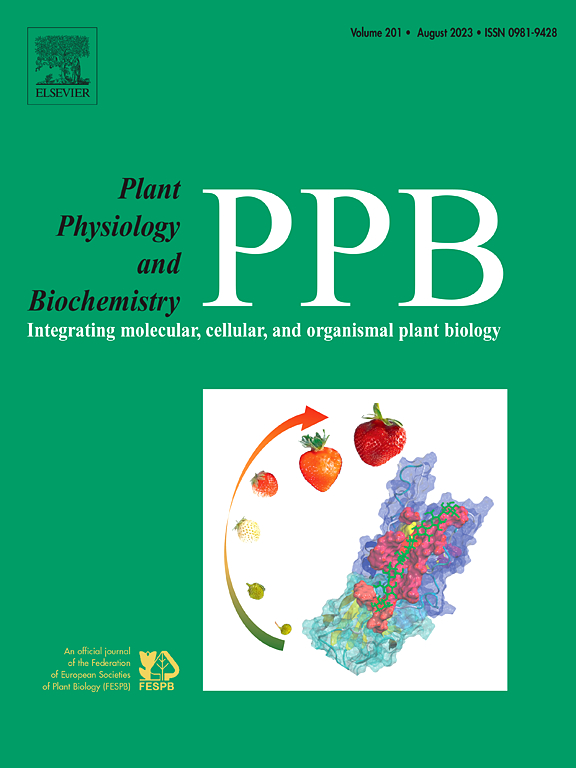Identification and functional analysis of wheat lincRNAs in response to Fusarium graminearum infection
IF 6.1
2区 生物学
Q1 PLANT SCIENCES
引用次数: 0
Abstract
Intergenic long non-coding RNAs (lincRNAs) have recently been recognized as pivotal regulators in plant-pathogen interactions. However, the specific regulatory mechanisms of lincRNAs responding to Fusarium graminearum (F. graminearum) infection remain largely unexplored. Here, we performed time-series transcriptome profiling (0, 24, 48, and 72 h post-inoculation) and systematic identification of lincRNAs. A total of 1238 expressed lincRNAs were identified, among which 548 were differentially expressed lincRNAs during the time course of F. graminearum infection. We further predicted cis-regulatory lincRNA-mRNA pairs, comprising 347 lincRNAs and potential 1015 target genes, which were found to be mainly involved in amino acid metabolism and biosynthetic pathways. Moreover, 19 lincRNAs were predicted as putative precursors or endogenous target mimics of miRNAs. Subsequently, we verified that two lincRNAs, MSTRG.6494 and MSTRG.32080, showed strong transcriptional responses to F. graminearum infection by quantitative real-time PCR (qPCR) screening. Silencing MSTRG.6494 reduced the expression level of defense-related genes, resulting in reduced resistance to fungal pathogenicity. Meanwhile, the expression level of the potential target gene ATP synthase subunit beta (TaATP2) was significantly decreased in MSTRG.6494-silenced plants infected with F. graminearum. Overall, we performed the genome-wide identification of lincRNAs and their possible regulatory networks during F. graminearum infection-related process, confirming that MSTRG.6494 participates in wheat resistance to F. graminearum, may be via targeting TaATP2 to enhance defense responses. Our findings provide new insights into the regulatory mechanism of lincRNAs for Fusarium head blight (FHB) resistance, suggesting this mechanism as an essential strategy for protecting wheat from F. graminearum.
小麦抗禾谷镰刀菌lincrna的鉴定及功能分析
基因间长链非编码rna (lincRNAs)最近被认为是植物与病原体相互作用的关键调控因子。然而,lincrna对谷物镰刀菌感染的具体调控机制在很大程度上仍未被探索。在这里,我们进行了时间序列转录组分析(接种后0、24、48和72小时),并系统地鉴定了lincrna。共鉴定出1238个表达的lincrna,其中548个在F. graminearum感染的时间过程中差异表达。我们进一步预测了顺式调控的lincRNA-mRNA对,包括347个lincrna和潜在的1015个靶基因,这些基因主要参与氨基酸代谢和生物合成途径。此外,19种lincrna被预测为mirna的假定前体或内源性靶模拟物。随后,我们通过实时荧光定量PCR (qPCR)筛选验证了MSTRG.6494和MSTRG.32080这两个lincrna对F. graminearum感染表现出强烈的转录应答。沉默MSTRG.6494降低了防御相关基因的表达水平,导致对真菌致病性的抗性降低。同时,mstrg .6494沉默植株中潜在靶基因ATP合成酶亚基β (TaATP2)的表达量显著降低。总体而言,我们对小麦赤霉病菌感染相关过程中的lincrna及其可能的调控网络进行了全基因组鉴定,证实MSTRG.6494可能通过靶向TaATP2增强防御反应参与小麦对小麦赤霉病菌的抗性。我们的研究结果为lincrna对小麦赤霉病抗性的调控机制提供了新的见解,表明该机制是保护小麦免受赤霉病侵袭的重要策略。
本文章由计算机程序翻译,如有差异,请以英文原文为准。
求助全文
约1分钟内获得全文
求助全文
来源期刊
CiteScore
11.10
自引率
3.10%
发文量
410
审稿时长
33 days
期刊介绍:
Plant Physiology and Biochemistry publishes original theoretical, experimental and technical contributions in the various fields of plant physiology (biochemistry, physiology, structure, genetics, plant-microbe interactions, etc.) at diverse levels of integration (molecular, subcellular, cellular, organ, whole plant, environmental). Opinions expressed in the journal are the sole responsibility of the authors and publication does not imply the editors'' agreement.
Manuscripts describing molecular-genetic and/or gene expression data that are not integrated with biochemical analysis and/or actual measurements of plant physiological processes are not suitable for PPB. Also "Omics" studies (transcriptomics, proteomics, metabolomics, etc.) reporting descriptive analysis without an element of functional validation assays, will not be considered. Similarly, applied agronomic or phytochemical studies that generate no new, fundamental insights in plant physiological and/or biochemical processes are not suitable for publication in PPB.
Plant Physiology and Biochemistry publishes several types of articles: Reviews, Papers and Short Papers. Articles for Reviews are either invited by the editor or proposed by the authors for the editor''s prior agreement. Reviews should not exceed 40 typewritten pages and Short Papers no more than approximately 8 typewritten pages. The fundamental character of Plant Physiology and Biochemistry remains that of a journal for original results.

 求助内容:
求助内容: 应助结果提醒方式:
应助结果提醒方式:


